
When it comes to disaster preparedness and management, it is so critical to continue to learn, and to know what’s next. This week, Executive Director Meaghan Enright and Operations Manager Mandy Lemley traveled to New York City to attend the National Disaster and Emergency Management Expo, a conference focused on new trends, products, and strategies in the disaster and emergency management space.
Several seminars were of particular interest, including two presentations by SBP, a nonprofit founded in Louisiana that works in disaster recovery across the country. The SBP presentations, on racial and social equity in disaster and supporting rural communities impacted by disaster, both spoke to the challenges that the U.S. Virgin Islands faces in our recovery.
Another panel of particular interest related to weather forecasting and disasters. Andrew Kruczkiewicz, a Senior Staff Associate at Columbia Climate School International Research Institute for Climate and Society spoke about integrating forecasting into decision making. For example, using seasonal precipitation forecasts to identify regions at higher than average risk of floods, and deploying resources accordingly. This type of forecasting is particularly useful for national and international humanitarian aid organizations, but can also be useful on a smaller scale when it comes to understanding local flash flooding risks.
Another area of interest presented at the conference was the potential applications of machine learning in disaster preparedness and response. For St. John and the greater U.S. Virgin Islands, we are particularly interested in the use of A.I. to expedite preliminary damage assessments in the aftermath of disasters. Expediting the timeline PDAs accelerates distribution of disaster relief funding, and AI technology can also help ensure that damage awards more accurately reflect the cost of reconstruction.
The final session on Thursday, November 17th was titled “The Next Generation : Climate Change and Disaster Management Perspectives”. Sessions like this are great examples of the high level conversations that drive innovation and progress across the industry. As Love City Strong continues to grow and expand our work in disaster preparedness, response, recovery, and mitigation, we need to keep in mind the developing impacts of climate change as well as trends and new approaches within the field. Spending a few days away from the Territory with like-minded disaster management professionals is an excellent opportunity to infuse new ideas and perspectives into our work.
Marking anniversaries can be a complicated thing, particularly when it comes to disasters. Do you mark a date? An hour? A minute? Is it appropriate to remember the moment the devastation began, or the moment it ended? The St. John community and the greater US Virgin Islands were hit by Hurricanes Irma and Maria two weeks apart, to the day, in 2017. Do we mark the 6th? The 20th? Both?
Today, as I reflect on September 2017, I find myself wanting to mark different dates. I want to remember the dates on which this community came together, the dates that showed just how remarkable the residents of this Territory are.
I remember the St. John community gathering on Friday, September 8th, in Mongoose Junction, having come together to assess the damage and begin trying to rebuild. I remember restaurant owners, managers, and staff making plans to utilize this generator and that walk-in and these kitchens, to ensure that free food was available for whoever needed it. That same day, I remember getting the first message that help was coming – not a formal alert of any kind, but a message from a friend, telling me that private boats were coming from Fajardo, Puerto Rico, to bring supplies and help with evacuations. I remember helping to organize a system that put 40 people on that first boat, and I remember the captain and crew telling us “we’ll be back tomorrow, first thing, with more boats”. From the first moment, relief was rooted in community.
I remember on Saturday, September 9th, more boats arriving from Puerto Rico, and also from Christiansted, St Croix. Small fishing vessels and larger charter vessels, laden with supplies donated by individuals and families who wanted to help and so donated their own emergency supplies. None of us knew then the true cost of these donations. I remember hugging friends and strangers, and putting them on boats and sending them on to whatever was next. I remember the flexibility and generosity of those who could have put a stop to the whole effort based on “protocol”, but who instead chose to acknowledge there was a need, and to let a group of well-intentioned volunteers find solutions.
If I’m honest, the next 10 days are a bit blurry, and I’d be hard pressed to put a date to most of my memories. But I remember how bright the stars were at night, with no man-made light to dim them.
I remember the 7 am meeting during which we found out Hurricane Maria was going to impact the Territory as a Category 5 storm, and I remember the way the air went out of the room.
Out of all the extraordinary things that happened in September of 2017, one that will always stand out is this: The day the ports were to close ahead of Maria, the crews from St Croix made one final trip. Even as a Category 5 storm bore down on St Croix, they came to St. John with more relief, then went home to haul out and batten down for their own disaster. I cried on the dock, with gratitude and astonishment and more than a little bit of fear, not knowing when, or if, we would see each other again.
I wrote on September 16th, 2017, “…for now, I can only say that everything has changed and yet the core of this place I call home remains the same, full of love, a strong sense of community, and the drive to rebuild.” Five years later I remain in awe of the strength and yes, resilience, of this community. One thing I know for sure is that as we move into a future of ever more complex and layered disasters, magnified by climate change and human development, it is critical that we remain committed to community-rooted resilience solutions.

Here we are in May, again, and it’s time to start thinking about our hurricane preparedness efforts. For those of us who live in “hurricane alley”, these tasks are annual habits. Forming habits can be helpful, but sometimes they can make us complacent. Each year, it’s important to revisit your emergency plan, check your kit, and make sure your home and family are ready for the season.
Threats from hurricanes include powerful winds, heavy rainfall, storm surges, coastal and inland flooding, rip currents, tornadoes, and landslides. Hurricanes can often undergo rapid intensification, meaning they can quickly gain strength before and as they make landfall. For this reason, it’s important to begin your preparation well in advance of an incoming storm. Before hurricane season starts, you should:
- Update your emergency plan with your family
- Check your insurance and strengthen your home
- Assemble disaster supplies
- Help your neighbors
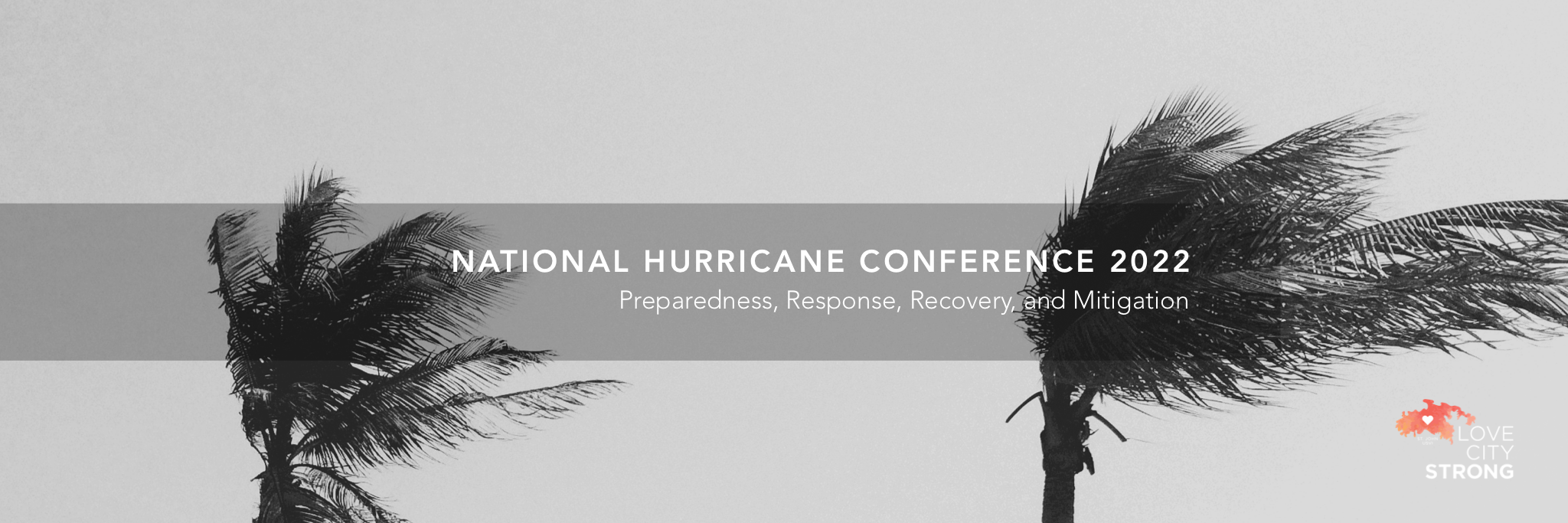
This week, I am pleased to be attending the 2022 National Hurricane Conference in Orlando. This annual event is focused on hurricane preparedness, response, recovery, and mitigation. Panels are focused on a variety of sectors, including technological developments, communications, forecasting, federal mitigation programs, public-private partnerships, and more.
One particularly exciting development this year is the presence of the Territory’s emergency management agency, VITEMA, on several panels. On Monday, Assistant Director Barbara Petersen, Deputy Director for Planning and Preparedness Regina Browne, Deputy Director of Operations Bruce Kelly, and Public Information Officer Erik Ackerson led a panel on local emergency response to the Covid-19 pandemic. Their presentation highlighted some of the challenges the Territory faced, as well as the many successes of VITEMA and the VI Department of Health over the last two years.
On Tuesday, Assistant Director Petersen and Deputy Director Browne hosted a panel focused on the Territory’s Hazard Mitigation & Resilience Plan. They were joined by Dr Greg Guannel, Director of the Green Caribbean Center at the University of the Virgin Islands. The robust discussion addressed climate change, infrastructure, and the need for systemic solutions to complex problems in the Territory.
Wednesday afternoon is dedicated to the NHC General Session. This event will include an appearance by FEMA Administrator Deanna Criswell as well as an Equity in Disasters panel. The Territory’s own Regina Browne is a panelist for the Equity in Disasters session. Along with her, a diverse group of representatives from emergency management organizations and nonprofits will discuss the importance of planning to ensure equity in disaster response.
While the VITEMA panels have certainly been relevant to our work at LCS, other opportunities abound. The NHC provides an invaluable chance to network with emergency managers, federal responders, vendors and subject matter experts from across the country. While each disaster is unique, there’s a great deal we can learn from the experiences of other communities, and we hope that our experiences are valuable to them as well. I am thrilled to be back at the National Hurricane Conference this year, and am already looking forward to next year’s meeting in New Orleans.
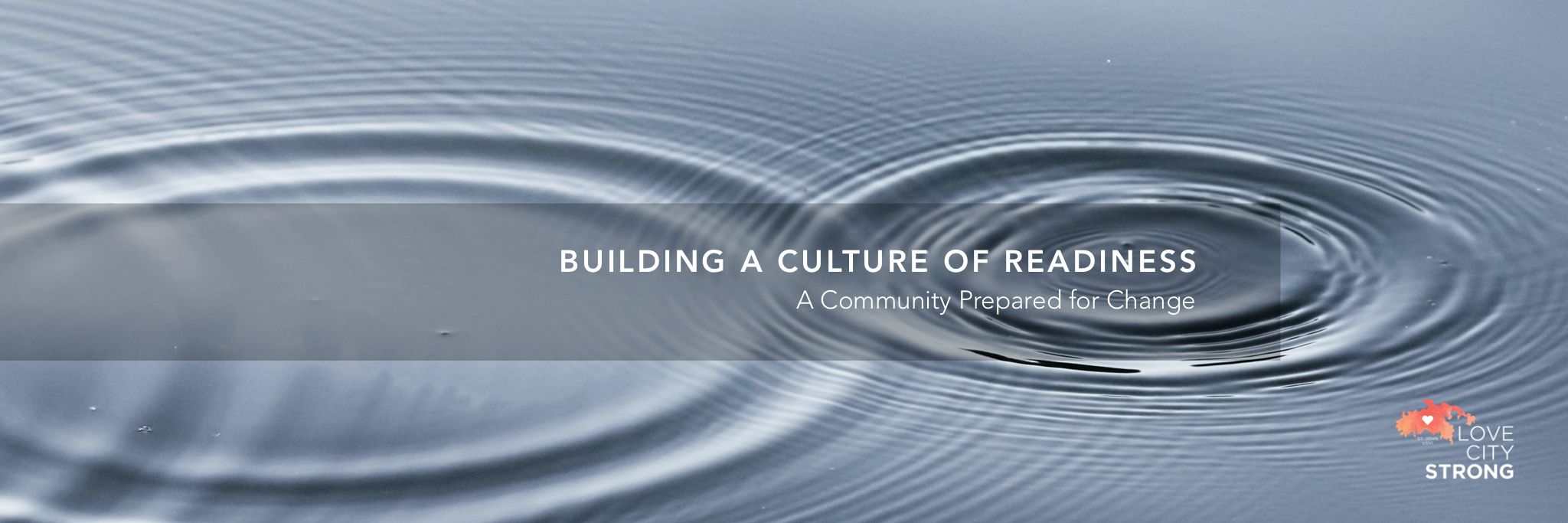
What is a “culture of readiness”, and why is it important? We often hear about building a culture of preparedness, in the context of emergency management. However, as a community recovers from a disaster impact they must not only be prepared, they must be ready for and open to change. The same is true for a society in the throes of a pandemic, learning the “new normal”. Change is inevitable, and a resilient and ready community embraces this truth.
The Influence of Culture
All people are influenced by cultural factors that shape their decisions and viewpoints. Each of us grow up learning how to value certain ways of doing and perceiving things. Culture is the ultimate cross-sector exercise, encompassing economics, belief systems, family structure, child-rearing, nature, and even risk management. Even seemingly unrelated areas of our lives are tied together by culture. In small, close knit communities like the US Virgin Islands, and St John in particular, culture influences decisions daily.
A Culture of Preparedness
One of the reasons that a grassroots approach to preparedness and readiness is so important is that if community engagement does not align with the community’s culture, the effort will not be sustainable. FEMA identifies the four guiding principles of culturally informed preparedness initiatives as Trust, Inclusion, Cross-Cultural Communication, and Support for Local Practices and Successes. Given these four components, a community can build sustainable preparedness practices.
FEMA’s stated goal of building a “culture of preparedness” is centered on achieving a certain level of cultural buy-in about preparing for disasters. Often, communities who have not been impacted don’t share the sense of urgency that characterize communities in recovery. A shared culture in this area would normalize the conversations necessary to increase preparedness before an impact, rather than after the fact. However, the question remains: Is a “prepared” community also necessarily a “ready” community?
Beyond Preparedness, to Readiness
A culture of readiness embodies not just preparedness but a willingness to move towards something different. This openness then enables healthy and sustainable change. Whether you’re building a change-ready organization or community, remaining open to feedback, is a critical trait. Feedback, whether in the form of questions, challenges, or disagreement, often helps to drive meaningful change. Challenging your own assumptions can result in more effective solutions. An organization or community can benefit from discussion in the same way, often identifying unmet needs, underserved populations, or underperforming sectors through public engagement. Therefore, it is important, within a culture of readiness, to establish structures that allow people to be actively involved in decision making processes, bringing in the right stakeholders at the right level at the right time. When the whole community feels included and heard, change feels less stressful and more intentional.
Our goal at Love City Strong is to build a culture of readiness within our community. As we recover from the twin Category 5 hurricanes of 2017 and emerge from the last two years marked by global pandemic, the Virgin Islands community truly understands that preparedness and readiness go hand in hand. We must be prepared for future climate related crises, and we must also be ready for the rapid period of change in which we find ourselves.

As 2021 comes to an end, I find myself filled with gratitude for our team, our supporters, and our partners.
Our team accomplished so much this year. We helped the VI Department of Health with community vaccinations, VITEMA with sandbag distribution for the island’s seniors, and many other departments and private organizations on projects great and small. I feel fortunate to work alongside such a hardworking, dedicated group of individuals.
Our donors were more generous than ever in 2021, especially our monthly donors. I am continuously humbled by the kindness you show and the trust that you place in us. Your kindness makes our impact possible.
Additionally, we were fortunate to have strong community partners who assisted us with fundraising. I’d like to especially thank St. John Hardware, St. John Brewers and High Tide. With their help we’ve been able to continue repairing and rebuilding homes, care for the island’s seniors, and train our team to be better first responders.
In 2022, our commitment to housing recovery will continue with the expansion of the Resilient Housing Initiative (RHI). The program will include more clients for small repairs and even more full rebuilds. We are also welcoming new additions to our management team and to our Board of Directors. I know that they will help us grow even stronger in the years to come.
From all of us at Love City Strong, Happy New Year!
Meaghan Enright
Executive Director
meaghan@lovecitystrongvi.org
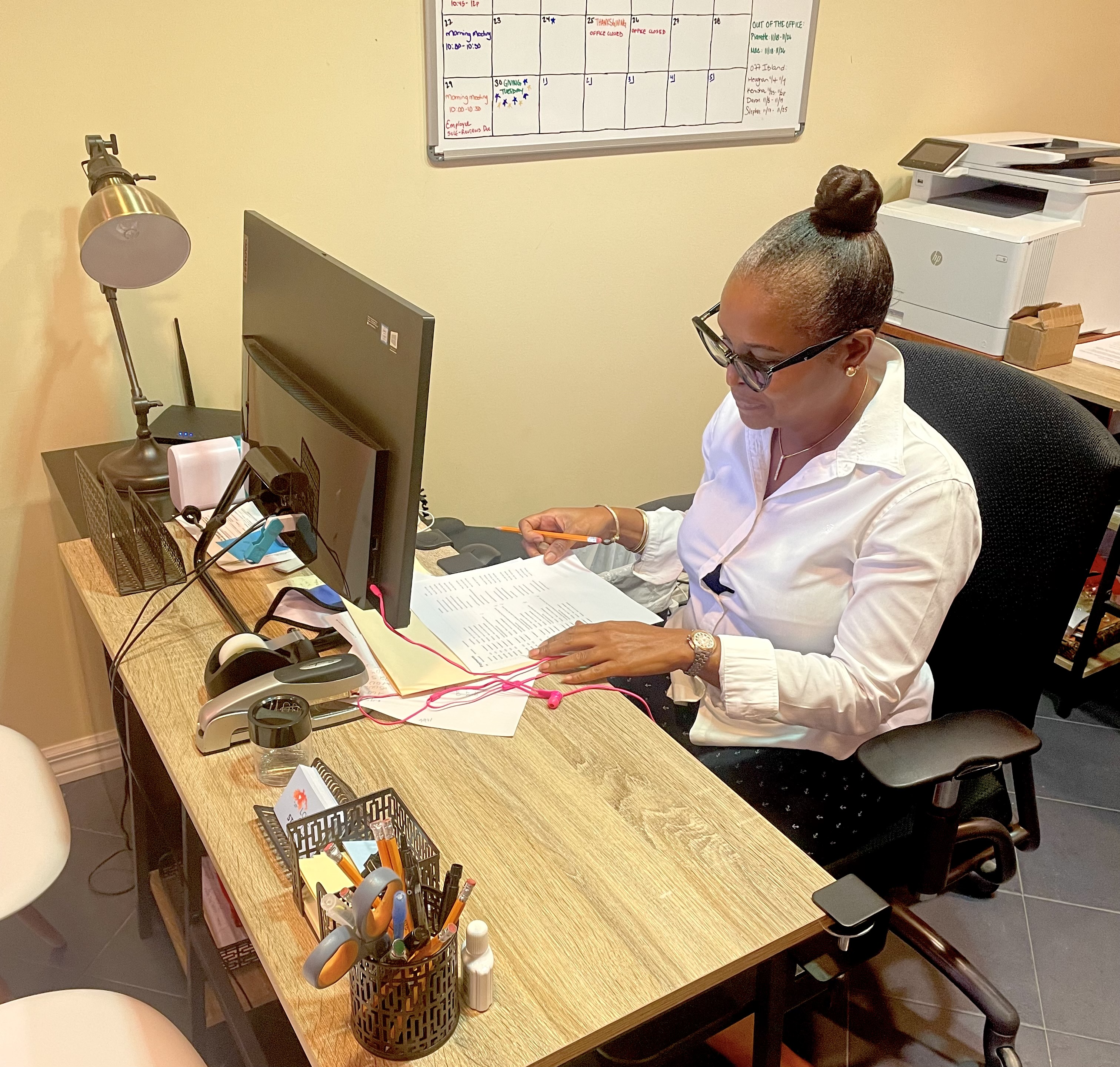
The Administrative Team primarily works in our office and helps Love City Strong from behind the scenes. They are not as visible as the Go Team and the Ops Team, but their role is still crucial!
Who are the Admin Team?
The Admin Team are a team of two who report directly to our Executive Director: The Foundation Administrator and the Development Director. Each person has separate duties, but they both work together to keep us funded and ensure that we’re spending our funding responsibly.
What does the Admin Team do?
The Foundation Administrator handles our accounting, record keeping, and compliance. They record our donations, and get our employees and partners paid for their work. The Administrator also ensures that we are transparent and up to date with local and federal requirements. They renew our licenses and keep our records up to date.
The Development Director’s job is to make sure that we are funded, and inform our donors about what we’re working on. When they’re not busy staying in touch with our donors via handwritten notes and personalized tours of our work, they write our grant reports and seek out new funding opportunities. They’re also tasked with keeping the public informed with our blog, social media, and newsletter.
Helping Us Help Others
We couldn’t support our community if the Admin Team didn’t support us. While not always visible in the community, they are still critical to the smooth operation of our projects. Support their hard work and donate today.

In the last 4 years we’ve accomplished so much thanks to the support of our Board, the generosity of our donors, and the partnerships that we’ve built. Your kindness and trust has made our impact possible.
As we enter our fifth year, we wanted to take a moment to summarize our work thus far and share how we create our different programs.
From 2018 to now, Love City Strong has:
- Rebuilt 36 homes.
- Installed 70 water filtration systems, serving 223 people. As a result, we replaced the consumption of 2,680 plastic water bottles per month.
- Remediated mold in over 100 homes.
- Made or replaced 200 address signs for seniors and families.
- Pre-staged MREs and boxed water across the island to last 5,000 people for one week after a disaster.
- Delivered sandbags to an average of 75 seniors per year.
- Trained more than 50 people across multiple first responder programs, like CERT and Stop the Bleed.
- Delivered 12,000 meals directly to seniors and families during the first COVID-19 lockdown.
- Distributed over 4,000 reusable masks throughout the community.
- Supported mass-vaccination efforts on St. John for 8 weeks, helping hundreds of residents and visitors to get their shots.
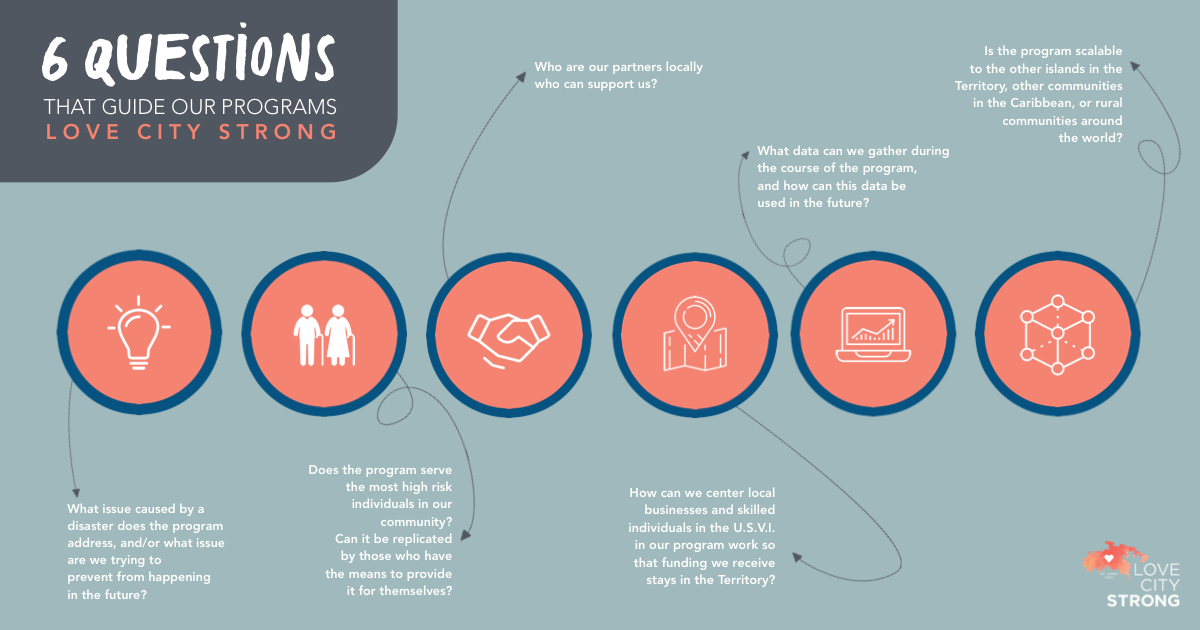
When our team gets together to brainstorm a new program, we start by asking ourselves the following 6 questions:
- What issue caused by a disaster does the program address, and/or what issue are we trying to prevent from happening in the future?
- Does the program serve the most high risk individuals in our community, and can it be replicated by those who have the means to provide it for themselves?
- Who are our partners locally that can support us?
- How can we center local businesses and skilled individuals in the U.S.V.I. in our program work so that funding we receive stays in the territory?
- What data can we gather during the course of the program, and how can this data be used in the future?
- Is the program scalable to the other islands in the territory, other communities in the Caribbean, or rural communities globally?
- We are addressing the massive loss in permanent low and middle income housing suffered as a result of Hurricanes Irma and Maria. Moreover, we want to rebuild homes so that they’re more storm resilient in the future.
- The program serves seniors, families with children and infants, and individuals with a disability or a chronic health condition. All of our clients are typically underserved by existing hurricane recovery/rebuild programs.
- We identified the St. John Community Foundation to help us with case management and All Hands and Hearts (who were on an extended mission in the USVI at the time) to help with on-site labor via their volunteers.
- We hired St. John-based construction companies and licensed contractors to perform all rebuild work, purchased our supplementary tools and equipment from businesses on St. John and St. Thomas when possible, and ordered building materials either from local suppliers or from Puerto Rico.
- We keep track of all of our expenses for each site to help federal partners like FEMA. This facilitates a better understanding of the true cost of housing rebuild on St. John; factoring in volunteer labor, shipping, and more.
- With local case management who live in and are a part of the community that they serve; strong partnerships with local contractors and suppliers; and access to both private and government funding, this program can be replicated in communities similar to St. John.


Our Operations Team plays a vital role in ensuring that we are prepared to respond to any kind of emergency that may arise. They are the backbone of our Disaster Preparedness programming. Alongside our Go Team, the Ops Team are the most visible members of our staff.
Who Are the Ops Team?
The Operations Team (aka the Ops Team) consists of the Operations Manager and the Asset Manager.
These two hardworking individuals work in tandem to meet our supply and equipment needs, and have different assigned duties and responsibilities that keep all of our programs running smoothly from the back end. They are also critical in ensuring that we stand ready to support our community in a crisis.
What Does the Ops Team Do?
We definitely couldn’t do our jobs without the Asset Manager! At Love City Strong, we believe in striving to meet our clients where they are instead of asking them to come to our office. Our Go Team is constantly in the field visiting clients who are receiving program services and performing home visits for seniors. To make this possible, we are privileged to give our teams company vehicles to use during the workday. We put a lot of miles on these vehicles, and that means they often need a lot of maintenance. The Asset Manager keeps our vehicles clean and running, addressing any maintenance issues and conducting safety checks every month. This is critical to ensuring that we can keep providing personalized, curated experiences for our clients.
The Operations Manager makes sure that we are receiving different first responder training every year. They research, coordinate, and provide the supplies for all of our staff training so that we are as prepared as possible to help others. Members of our team have received training in first aid, CPR, Emergency Medical Response (EMR), Community Emergency Response Team (CERT), Point of Distribution (POD), Chainsaw Sawyer, and more thanks to our Operations Manager’s hard work and dedication.
To better serve our community when there is a crisis, Love City Strong has 3 storage spaces across the island that house a variety of supplies. First aid supplies, road clearing supplies, portable solar lights, MREs, and boxed water are just some of the many supplies that we have ready to go if a disaster strikes. The Ops Team keeps these spaces inventoried, clean, and accessible if we ever need them.
They also meet regularly to research and assess other potential hazards to the community, and create plans to address those hazards through the ordering and stockpiling of supplies and equipment. Our Ops Team was critical in ensuring that we had PPE like masks, gloves, hospital gowns, and hand sanitizer in our possession before the first case of COVID-19 in the Virgin Islands was ever reported. The forward-thinking of our Ops Team allowed us to give these supplies to healthcare professionals, first responders, and frontline workers immediately to ensure there were no supply gaps in the early months of the pandemic.
Our storage spaces also house supplies to support projects led by our government partners in the areas of preparedness and readiness. When we were asked to help with mass-vaccination efforts on St. John, we were able to respond right away with tables, chairs, tents, PPE, office supplies, and hand sanitizer thanks to our Ops Team.
Key to Our Success
The Operations Team stays busy making sure that the Go Team, the seasonal Go Team, and our contractors have everything they need to be successful. They have a wealth of knowledge and skills, and are always thinking about what we can do to run our programs efficiently and fairly.
Donate today to ensure that our Operations Team has everything they need to support us, so that we can continue to support St. John.
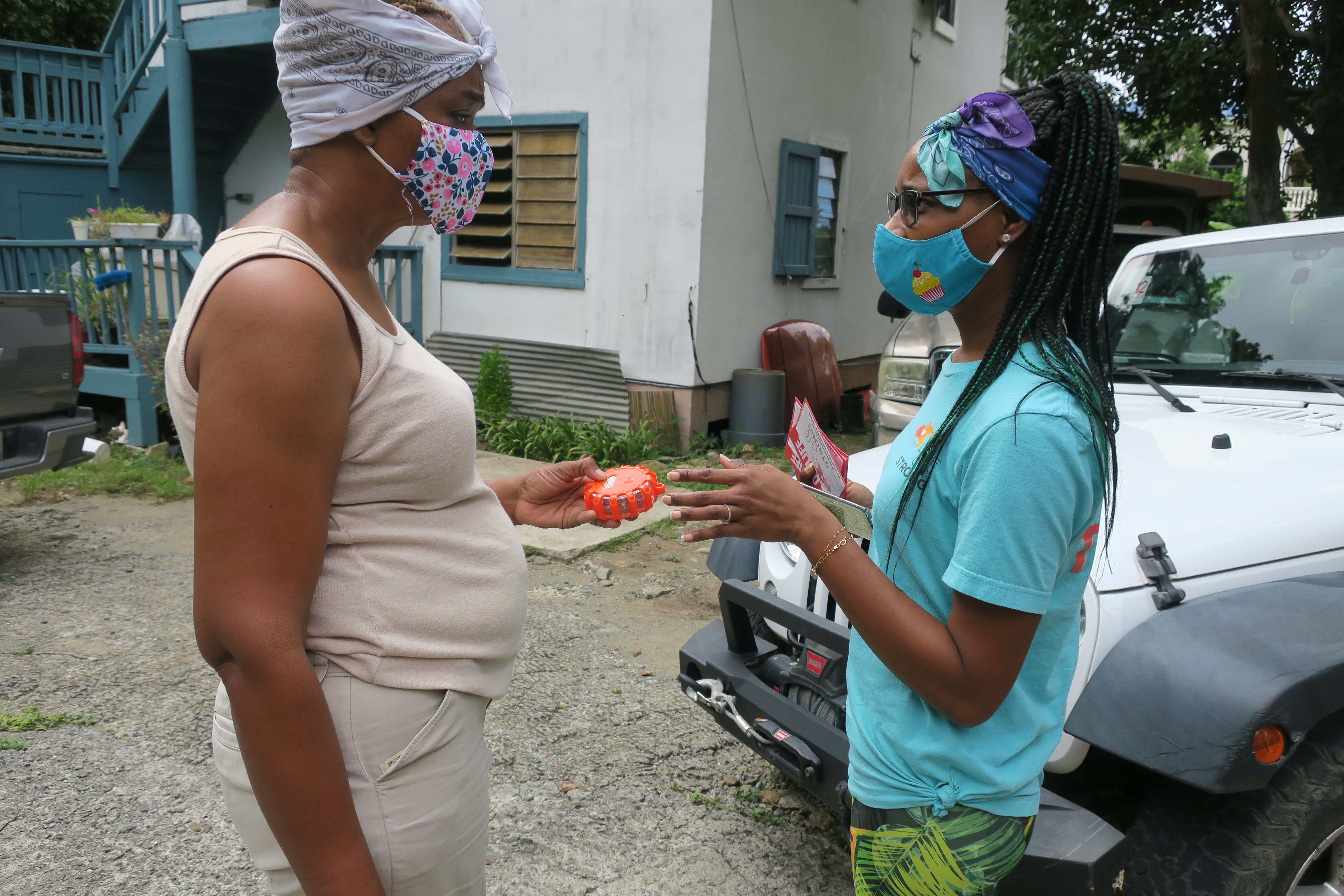
On St. John, you may see a group of people wearing bright teal shirts driving all across the island in a hurry. They can be spotted at community events, visiting seniors at home, or delivering emergency preparedness supplies to seniors and families.
Who are these friendly, cheerful folks in their bright shirts? They are the Love City Strong Go Team!
Why is it called the “Go Team?”
Our Go Team was modeled after the group of volunteers that worked alongside our founders after Hurricanes Irma and Maria. Together with Global DIRT, we enlisted over 50 individuals from all across the island to go into the community and help those in need. These volunteers were nicknamed the “Go Team” because they are always “on the go,” and the name stuck!
For 3 months after the hurricanes, the Go Team delivered relief supplies from a variety of outside agencies, helped people clean their properties, connected individuals with resources, managed the massive amount of in-kind donations arriving on St. John, and gathered data used by federal agencies like the US Army Core of Engineers’ Blueroof Program.
Our Team Reflects Our Community
When Love City Strong’s founders decided to form LCS into an official NGO, we knew that we wanted the Go Team to be a part of the organizational structure. We learned early on the value of disaster survivors seeing themselves reflected in the response and recovery process. People were more likely to accept help from their friends and neighbors than from outsiders who they didn’t recognize.
From the beginning, we made sure that the Go Team reflected the diversity of the St. John community. Though its members and its size have changed over the years, the Go Team has always been made up of individuals from a variety of backgrounds, age groups, and from different areas of the island. All of our employees, including the Go Team, are either Virgin Islanders or transplants who have lived on St. John for at least 5 years. This has been crucial to our success as an organization.
What Does the Go Team Do?
During the Atlantic Hurricane Season, the Go Team spends their time going through extensive first responder training. They also execute our annual preparedness outreach programs, such as sandbag deliveries to seniors alongside the VI Dept. of Public Works.
Every July, we hire a group of 10 to 15 seasonal members of the Go Team. They can be quickly deployed alongside our core team if a major disaster strikes. The seasonal members receive first responder training as well, and help us with a variety of outreach tasks throughout peak hurricane season.
Throughout the rest of the year, the Go Team are the ones executing our preparedness and mitigation programs. They change filters for seniors involved in our Water Filtration program; drive seniors to their flu shot appointments; build and post address signs for homes that do not have visible addresses, and more. In 2020, they hand delivered hundreds of meals from World Central Kitchen to seniors and families every week from Cruz Bay to the East End of St. John.
They also keep in touch with clients who are receiving program benefits from a contractor or business partner. For example, they make regular visits to those whose homes are being rebuilt through our Resilient Housing Initiative (RHI) program. They firmly believe in meeting our clients where they are, rather than making them come to our office. This allows our clients to feel comfortable and creates a more personal experience for them while they are enrolled in one of our programs.
The Go Team is always ready to lend a hand to any group or agency for a disaster preparedness or mitigation project. For example, when the VI Dept. of Health and FEMA asked for our help with vaccination pop ups on St. John, the Go Team led the charge.
The Core of LCS
The Go Team are the heart of everything that we do. They provide familiar, friendly faces for our clients. Often take on multiple projects and tasks every month for LCS and for our partners. Nothing that we do would be possible without their hard work and dedication to our mission.
If you are on St. John, and you see their teal shirts on the go, be sure to wave and say hello! The Go Team might not be able to stop and chat, but they’ve always got time for a smile. Donate today to help the Go Team keep doing their important work.
